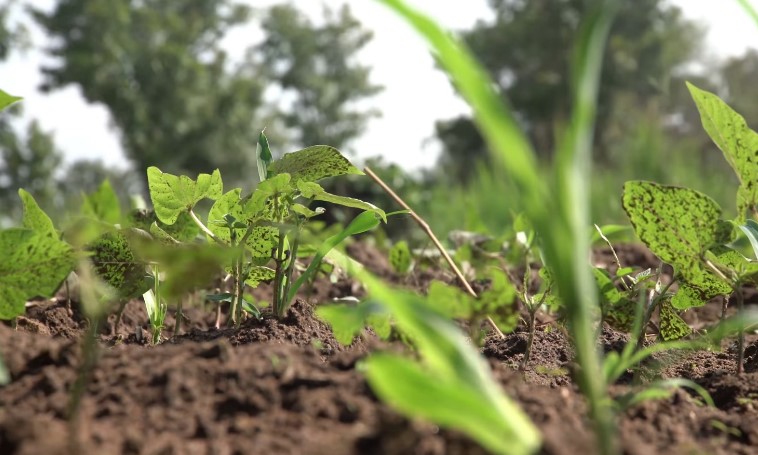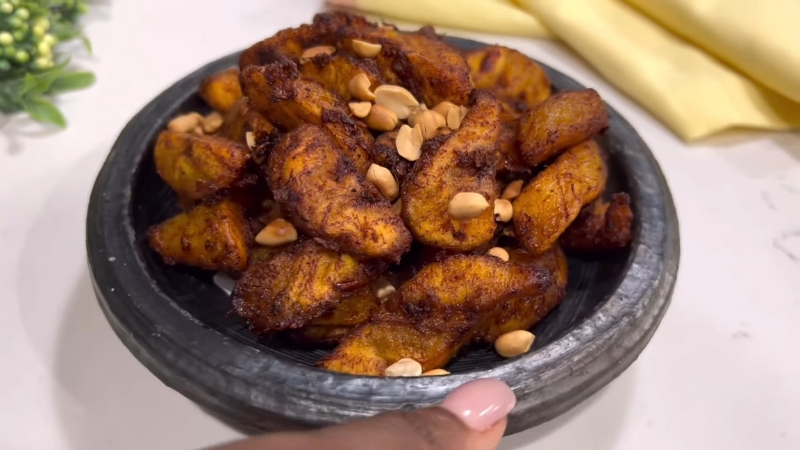
Few street foods in West Africa command the same level of late-night devotion as kelewele. In Ghana, when the air cools and the streetlights flicker on, small stands pop up with nothing more than a wok, a stack of ripe plantains, and the unmistakable scent of ginger and hot pepper.
Table of Contents
ToggleThe sound of sizzling oil draws people in, and out comes golden chunks of sweet, spicy plantain – crisp on the edges, creamy inside, and perfectly paired with roasted groundnuts.
Let’s walk through what makes kelewele so beloved, how to prepare it at home without losing its street-side charm, and a few smart tricks to nail the texture every time.
The Core Formula
To make classic kelewele, you only need three essentials:
- Ripe plantains (yellow with black streaks)
- Ginger-chile marinade with salt and sometimes onion
- Hot oil at around 350 °F (175 °C)
That temperature is key. According to Serious Eats, frying plantains at 350°F gives you golden caramelization without a greasy finish. If the oil is cooler, the plantains soak it up; too hot, and they burn before cooking through.
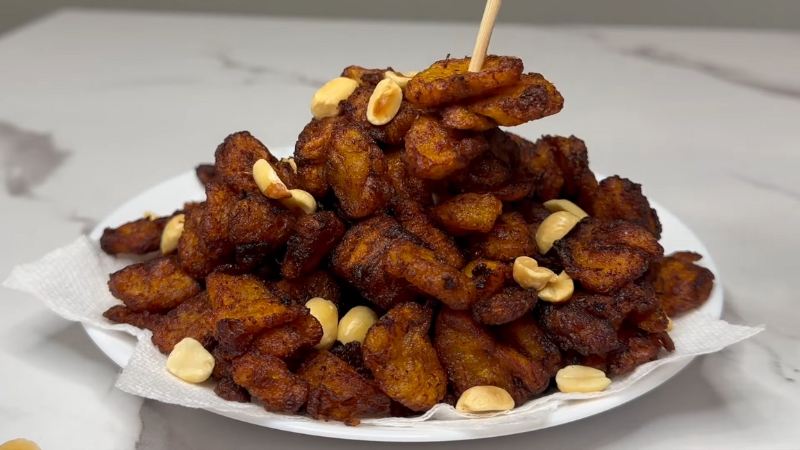
Classic Ghanaian Kelewele (Spicy Fried Plantains)
Equipment
- Large mixing bowl
- Grater or blender for ginger, onion, garlic
- Sharp knife and cutting board
- Deep frying pan or wok
- Slotted spoon or spider strainer
- Paper towels or wire rack for draining
- Optional: Cooking thermometer recommended for oil temperature control
Ingredients
- 4 ripe plantains (yellow with black patches) peeled and cut into 2–3 cm chunks
- 3 tbsp fresh ginger, grated
- 1 small red onion, grated or puréed
- 1-2 fresh hot peppers (e.g. Scotch bonnet) or 1–2 tsp cayenne pepper
- 1 tsp salt
- 1 tsp ground cloves optional
- 1 tsp ground nutmeg optional
- ½ tsp cinnamon or anise seed optional
- 1-2 garlic cloves, grated optional
- Neutral oil for deep frying (canola or sunflower), enough for 2–3 inches depth
- Roasted peanuts (groundnuts), to serve
Instructions
- Make the Spice PasteIn a bowl, mix grated ginger, onion, hot pepper or cayenne, salt, and optional spices (cloves, nutmeg, cinnamon, garlic). Let it sit for 5 minutes to mellow.
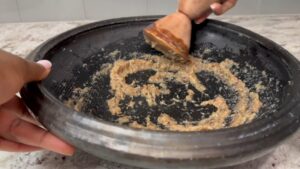
- Prep and Cut PlantainsPeel the ripe plantains and cut them into evenly sized chunks or wedges (about 2–3 cm). Uniform size ensures even frying.
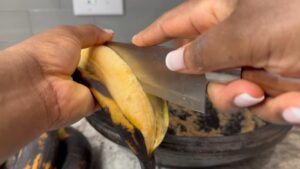
- Marinate the PlantainsToss the plantain pieces in the spice paste until fully coated. Let them rest for 10–15 minutes at room temperature to absorb flavor.
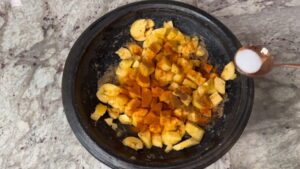
- Heat and FryHeat neutral oil in a deep pan to 350°F (175°C).Fry plantains in small batches for 4–6 minutes, stirring occasionally, until golden brown and crisp on the edges.
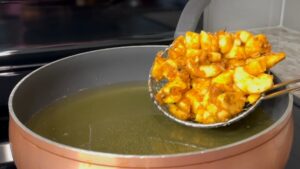
- Drain and ServeRemove fried plantains with a slotted spoon and drain on paper towels. Serve hot with roasted peanuts on the side or sprinkled over the top.
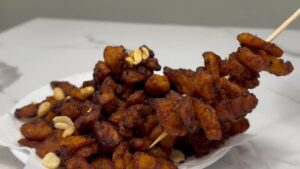
Video
Notes
Cooking Tips
- Oil Control: Keep the oil at 350°F. Too low = greasy; too high = burnt outside, raw inside.
- Spice Swap: Try grains of selim or aniseed for a smoky twist.
- Frying Alternative: Bake at 425°F (220°C) for 25 minutes, flipping halfway. Or air-fry at 350°F for 15–20 minutes.
- Crispiness Tip: Space plantains out in the oil; overcrowding cools it and ruins the texture.
Variations Across Ghana
Kelewele, pronounced Kay-lay-way-lay, is one of my favourite #Ghanaian dishes. It is consists of fried plantains seasoned with spices & served with rice & bean stew or alone as dessert or snack.Kelewele is is very simple to make at home: https://t.co/PN2sMHqAoN via @YouTube pic.twitter.com/pu8ZqfBBv4
— imane ouaadil (@ImaneOuaadil) February 20, 2022
No two homes season kelewele exactly the same. While the ginger-pepper core remains non-negotiable, cooks personalize it with spices and aromatics that reflect family or regional taste:
| Spice or Add-In | Effect | Common In |
| Cloves & Nutmeg | Sweet, warm complexity | Urban street stalls |
| Anise seed or grains of selim | Fragrant, slightly smoky | Traditional households |
| Cinnamon | Smooth sweetness | Restaurant versions |
| Garlic & Onion | Savory base | Common in home kitchens |
In Ghana’s bustling cities, you’ll even find vendors who tweak the spice level depending on the time of night: hotter batches for late hours when the crowd thins.
Baked and Air-Fried Versions
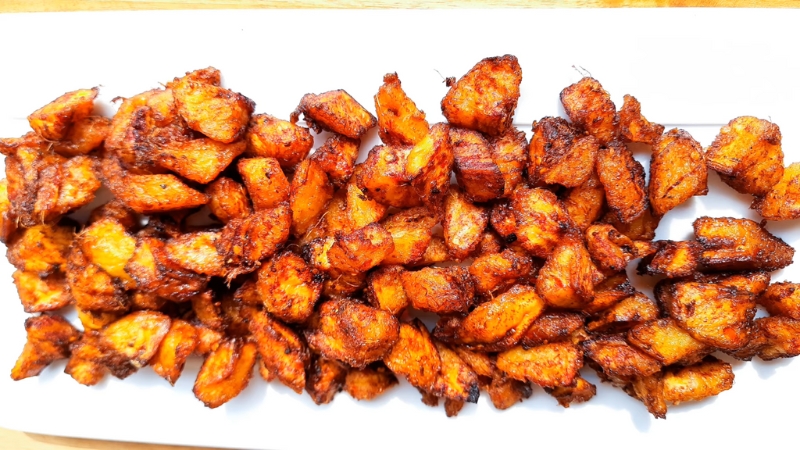
If you’d like to skip deep frying, both baking and air-frying can get surprisingly close to the real deal.
Oven Method
- Toss marinated plantains with 1-2 tablespoons of oil.
- Spread evenly on a parchment-lined sheet, leaving space between pieces.
- Bake at 425°F / 220 °C for about 25 minutes, flipping once halfway.
- Watch for darkened, crisp edges.
Air-Fryer Method
- Lightly oil the basket to prevent sticking.
- Set to 350 °F / 175 °C.
- Cook 15-20 minutes, shaking once or twice.
Recipe developers in Ghana’s diaspora community often recommend both methods for weeknight cooking. You lose a bit of the deep-fried texture, but the flavor stays spot on.
Serving Ideas and Pairings
Kelewele shines as a snack, but it also fits comfortably into a meal. Try pairing it with:
- Roasted groundnuts (peanuts): The standard street-corner combo.
- Red red: A hearty Ghanaian bean stew cooked in palm oil.
- Grilled meats or fish: Sweet plantains balance smoky flavors beautifully.
- Shito: A dark, spicy Ghanaian chili sauce that adds even more heat.
- Fresh salad greens: For a light, modern twist on the plate.
At home, many people serve kelewele alongside main dishes on weekends or bring it out at parties as finger food. In restaurants, it sometimes shows up as a side with grilled tilapia or jollof rice.
Problems and Resolutions Guide
| Problem | Likely Cause | Quick Fix |
| Greasy texture | Oil too cool or crowded pot | Fry in smaller batches; return to 350 °F between rounds |
| Pale, soft pieces | Oil not hot enough or marinade too wet | Pat dry before frying; raise heat slightly |
| Burnt edges, raw centers | Oil too hot | Lower to 340-350 °F and cut pieces evenly |
| Pieces falling apart | Plantains overripe | Choose fruit that’s yellow with black spots, not fully black |
Food Safety and Street-Food Hygiene
Street vendors in Accra have long made kelewele a nightlife staple, but large crowds and long frying hours sometimes raise hygiene concerns. At home, clean oil and consistent temperature solve most issues.
- Use fresh oil each time or strain and store properly.
- Keep utensils dry to avoid splattering.
- Avoid reusing oil more than twice—it darkens and affects flavor.
- Cool leftovers quickly and refrigerate in an airtight container.
If you ever wondered how vendors keep up with demand during busy nights, the trick is constant rotation: small batches fried quickly so nothing sits too long in oil.
A Short Note on Names and Roots
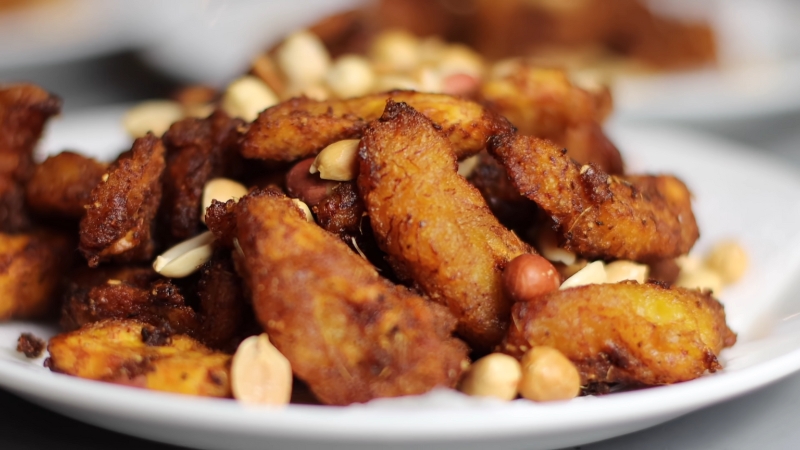
You may see similar dishes called aloco in the Ivory Coast or makemba in parts of Congo, but kelewele carries a distinct Ghanaian identity. The defining ginger-pepper marinade and the ritual of serving with roasted peanuts set it apart.
In Accra, vendors wrap servings in brown paper or plastic bowls and serve them piping hot, often late into the night when traffic fades and conversations stretch.
Kelewele’s popularity has spread far beyond Ghana. From London’s Ghanaian cafés to New York pop-ups, chefs are reintroducing it as both comfort food and culinary heritage, a connection to home through spice and scent.
FAQs
Where You’ll Find It
@amasavor Ghanaian Street Food: Kelewele 🇬🇭✨ Sweet, spicy, and full of flavor — this Kelewele hits every time! Made with ripe plantains, ginger, garlic, cloves, grain of selim, and a touch of heat from scotch bonnet pepper. Fried to perfection!! Would you try this spicy Ghanaian snack? This is street food GOLD — right from your kitchen. Save this recipe & tag a friend who needs to try it!🇬🇭✨ #Kelewele #GhanaianStreetFood #ghanafood #foodtutorial #ghanatiktok #ghanaianfood #Dm foodie #dmvcontentcreator #marylandcontentcreator #streetfoodvibes #asmr #asmrcooking #EasyRecipe #SpicySnack #PlantainLove #WestAfricanEats @From Our Place ♬ Real Thing – Kwesi Arthur
In Ghana, kelewele is an absolute phenomenon. You’ll find it sizzling near bus stations, beaches, and night markets from Osu to Kokomlemle.
It’s eaten standing, chatting, and sharing. Some vendors have loyal followings, and their seasoning secrets are passed down through generations.
In the diaspora, kelewele has found new forms; tucked into tacos at Afro-fusion restaurants, served with ice-cold beer at music festivals, or plated elegantly alongside braised meats. Yet the essence remains the same: humble ingredients transformed through spice and care.
Final Thoughts
Making kelewele at home connects you to one of Ghana’s most joyful food traditions. It’s fragrant, fiery, and completely addictive.
Many home cooks who explore Ghanaian recipes also enjoy learning how to cook clam stew the Ghanaian way, a coastal favorite that shares the same love for bold spice and warmth.
Once you’ve mastered the basics: ripe plantains, a gingery kick, and oil at the right temperature, you can start playing with spices, trying baked versions, or sharing a big bowl with friends.
It’s proof that the simplest foods, made with heart and heat, never go out of style.
Related Posts:
- How to Make Traditional Egusi Soup - A Step-by-Step Recipe
- How to Make Authentic South African Bunny Chow at Home
- How to Make Moambe Chicken – Traditional Congolese Stew
- How to Make Nigerian Suya Spice - Step-by-Step Guide
- How to Make Wonjo With Hibiscus and Pineapple
- What Are the Languages Spoken in Ghana? 12…














